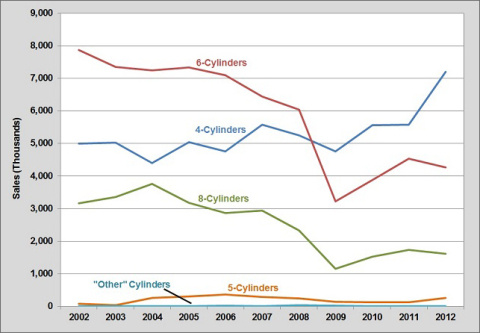Since 2002, there has been a shift away from eight- and six-cylinder engines and increased use of four-cylinder engines in new light vehicles. From 2002 to 2012, eight- and six-cylinder engines declined by nearly 50% (49% and 46%, respectively) while the use of four-cylinder engines increased by 44%. This shift toward smaller engines is attributable to advances in engineering that allow greater output from smaller engines. These advances are helping manufacturers to meet both Corporate Average Fuel Economy standards and consumer expectations. Other cylinder configurations like the three- and five-cylinder engines have never been widely used.
Sales of New Light Vehicles by Number of Cylinders, 2002–2012
Supporting Information
| Model Year | Number of Cylinders | Total | ||||
|---|---|---|---|---|---|---|
| 4 | 5 | 6 | 8 | Other | ||
| 2002 | 5,003 | 77 | 7,866 | 3,164 | 4 | 16,115 |
| 2003 | 5,021 | 40 | 7,346 | 3,359 | 6 | 15,773 |
| 2004 | 4,400 | 260 | 7,245 | 3,757 | 12 | 15,674 |
| 2005 | 5,034 | 305 | 7,340 | 3,180 | 16 | 15,875 |
| 2006 | 4,758 | 366 | 7,095 | 2,860 | 19 | 15,098 |
| 2007 | 5,576 | 297 | 6,434 | 2,946 | 17 | 15,270 |
| 2008 | 5,245 | 251 | 6,036 | 2,328 | 36 | 13,896 |
| 2009 | 4,762 | 149 | 3,232 | 1,150 | 19 | 9,312 |
| 2010 | 5,556 | 125 | 3,887 | 1,532 | 9 | 11,109 |
| 2011 | 5,582 | 130 | 4,542 | 1,740 | 8 | 12,002 |
| 2012 | 7,199 | 256 | 4,260 | 1,617 | 11 | 13,343 |
| Source: Environmental Protection Agency, Light-Duty Automotive Technology, Carbon Dioxide Emissions, and Fuel Economy Trends: 1975 through 2012, EPA-420-S-13-001, Appendix J, March 2013. | ||||||


